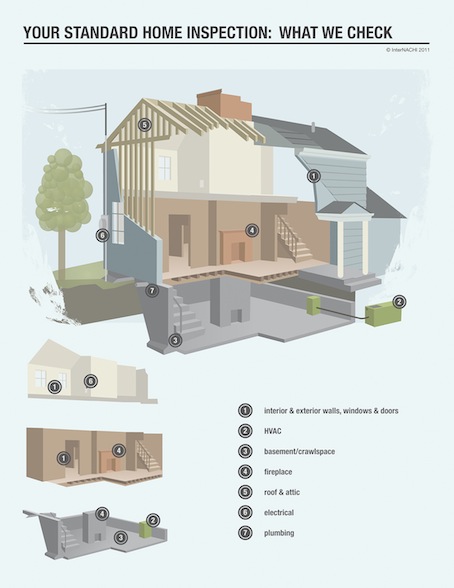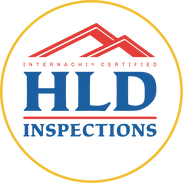|
|
|
What is a Home Inspection?
A general home inspection is a non-invasive, visual examination of the accessible areas of a residential property (as delineated below), performed for a fee, which is designed to identify defects within specific systems and components defined by the Standards of Practice that are both observed and deemed material by the inspector. The scope of work may be modified by the Client and Inspector prior to the inspection process.
A general home inspection report shall identify, in written format, defects within specific systems and components defined by the Standards of Practice that are both observed and deemed material by the inspector. Inspection reports may include additional comments and recommendations.
What we inspect:
Limitations:
A. The inspector is not required to determine:
A general home inspection is a non-invasive, visual examination of the accessible areas of a residential property (as delineated below), performed for a fee, which is designed to identify defects within specific systems and components defined by the Standards of Practice that are both observed and deemed material by the inspector. The scope of work may be modified by the Client and Inspector prior to the inspection process.
- The general home inspection is based on the observations made on the date of the inspection, and not a prediction of future conditions.
- The general home inspection will not reveal every issue that exists or ever could exist, but only those material defects observed on the date of the inspection.
A general home inspection report shall identify, in written format, defects within specific systems and components defined by the Standards of Practice that are both observed and deemed material by the inspector. Inspection reports may include additional comments and recommendations.
What we inspect:
- Roof: We inspect the roof-covering materials, the gutters, the downspouts, the vents, flashing, skylights, chimney, and other roof penetrations; and the general structure of the roof from the readily accessible panels, doors or stairs and observation of active roof leaks.
- Exterior: We inspect the exterior wall-covering materials, flashing and trim, all exterior doors, adjacent walkways and driveways, stairs, steps, stoops, stairways and ramps, porches, patios, decks, balconies and carports, railings, guards and handrails, the eaves, soffits and fascia, representative number of windows; and vegetation, surface drainage, retaining walls and grading of the property, where they may adversely affect the structure due to moisture intrusion, and any improper spacing between intermediate balusters, spindles and rails.
- Basement, Foundation, Crawlspace & Structure: We inspect the foundation, the basement, the crawlspace and structural components. Observed indications of wood in contact with or near soil, active water penetration, indications of possible foundation movement, such as sheetrock cracks, brick cracks, out-of-square door frames, and unleveled floors; and any cutting, notching and boring of framing members that may, in the inspector's opinion, present a structural or safety concern.
- Heating: We inspect the heating system, using normal operating controls, observed the location of the thermostat for the heating system, the energy source, the heating method and system or components accessibility.
- Cooling: We inspect the cooling system using normal operating controls, location of the thermostat for the cooling system, the cooling method system or components accessibility.
- Plumbing: We inspect the main water supply shut-off valve, the main fuel supply shut-off valve, the water heating equipment, including the energy source, venting connections, temperature/pressure-relief (TPR) valves, Watts 210 valves, and seismic bracing, Interior water supply, including all fixtures and faucets, by running the water, all toilets for proper operation by flushing, all sinks, tubs and showers for functional drainage, the drain, waste and vent system; and drainage sump pumps with accessible floats.
- Electrical: We inspect the service drop, the overhead service conductors and attachment point, the service head, gooseneck and drip loops, the service mast, service conduit and raceway the electric meter and base, service-entrance conductors, the main service disconnect, panel boards and over-current protection devices (circuit breakers and fuses), service grounding and bonding, a representative number of switches, lighting fixtures and receptacles, including receptacles observed and deemed to be arc-fault circuit interrupter (AFCI)-protected using the AFCI test button, where possible, all ground-fault circuit interrupter receptacles and circuit breakers observed and deemed to be GFCIs using a GFCI tester, where possible; and smoke and carbon-monoxide detectors.
- Fireplace: We inspect, readily accessible and visible portions of the fireplaces and chimneys, lintels above the fireplace openings, damper doors by opening and closing them, if readily accessible and manually operable; and cleanout doors and frames.
- Attic, Insulation & Ventilation: We inspect, insulation in unfinished spaces, including attics, crawlspaces and foundation areas, ventilation of unfinished spaces, including attics, crawlspaces and foundation areas; and mechanical exhaust systems in the kitchen, bathrooms and laundry area.
- Doors, Windows & Interior: We inspect a representative number of doors and windows by opening and closing them, floors, walls and ceilings, stairs, steps, landings, stairways and ramps, railings, guards and handrails; and garage vehicle doors and the operation of garage vehicle door openers, using normal operating controls.
Limitations:
- An inspection is not technically exhaustive.
- An inspection will not identify concealed or latent defects.
- An inspection will not deal with aesthetic concerns or what could be deemed matters of taste, cosmetic defects, etc.
- An inspection will not determine the suitability of the property for any use.
- An inspection does not determine the market value of the property or its marketability.
- An inspection does not determine the insurability of the property.
- An inspection does not determine the advisability or inadvisability of the purchase of the inspected property.
- An inspection does not determine the life expectancy of the property or any components or systems therein.
- An inspection does not include items not permanently installed.
- This Standards of Practice applies to properties with four or fewer residential units and their attached garages and carports.
A. The inspector is not required to determine:
- property boundary lines or encroachments.
- the condition of any component or system that is not readily accessible.
- the service life expectancy of any component or system.
- the size, capacity, BTU, performance or efficiency of any component or system.
- the cause or reason of any condition.
- the cause for the need of correction, repair or replacement of any system or component.
- future conditions.
- compliance with codes or regulations.
- the presence of evidence of rodents, birds, animals, insects, or other pests.
- the presence of mold, mildew or fungus.
- the presence of airborne hazards, including radon.
- the air quality.
- the existence of environmental hazards, including lead paint, asbestos or toxic drywall.
- the existence of electromagnetic fields.
- any hazardous waste conditions.
- any manufacturers' recalls or conformance with manufacturer installation, or any information included for consumer protection purposes.
- acoustical properties.
- correction, replacement or repair cost estimates.
- estimates of the cost to operate any given system.
- any system that is shut down.
- any system that does not function properly.
- or evaluate low-voltage electrical systems, such as, but not limited to:
1. phone lines;
2. cable lines;
3. satellite dishes;
4. antennae;
5. lights; or
6. remote controls. - any system that does not turn on with the use of normal operating controls.
- any shut-off valves or manual stop valves.
- any electrical disconnect or over-current protection devices.
- any alarm systems.
- moisture meters, gas detectors or similar equipment.
- move any personal items or other obstructions, such as, but not limited to: throw rugs, carpeting, wall coverings, furniture, ceiling tiles, window coverings, equipment, plants, ice, debris, snow, water, dirt, pets, or anything else that might restrict the visual inspection.
- dismantle, open or uncover any system or component.
- enter or access any area that may, in the inspector's opinion, be unsafe.
- enter crawlspaces or other areas that may be unsafe or not readily accessible.
- inspect underground items, such as, but not limited to: lawn-irrigation systems, or underground storage tanks (or indications of their presence), whether abandoned or actively used.
- do anything that may, in the inspector's opinion, be unsafe or dangerous to him/herself or others, or damage property, such as, but not limited to: walking on roof surfaces, climbing ladders, entering attic spaces, or negotiating with pets.
- inspect decorative items.
- inspect common elements or areas in multi-unit housing.
- inspect intercoms, speaker systems or security systems.
- offer guarantees or warranties.
- offer or perform any engineering services.
- offer or perform any trade or professional service other than general home inspection.
- research the history of the property, or report on its potential for alteration, modification, extendibility or suitability for a specific or proposed use for occupancy.
- determine the age of construction or installation of any system, structure or component of a building, or differentiate between original construction and subsequent additions, improvements, renovations or replacements.
- determine the insurability of a property.
- perform or offer Phase 1 or environmental audits.
- inspect any system or component that is not included in the Standards of Practice.
Cities and Towns I proudly serve;
- Duval County Florida Cities/Towns - Atlantic Beach, Jacksonville, Jacksonville Beach, Mayport, Neptune Beach
- St Johns County Florida Cities/Towns - Palm Valley, Ponte Vedra, Ponte Vedra Beach, St. Augustine, St. Augustine Beach, St. Augustine Shores, Switzerland, Vilano Beach
- Nassau County Florida Cities/Towns: - Amelia Island, Fernandina Beach. Yulee, Callahan

